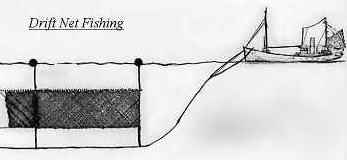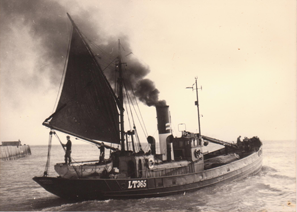Great Yarmouth History
Fish, Nets and Ships
The Herring
Herring, typically lie on the bottom during the day and rise to the surface at dusk to feed on plankton which constitutes their diet. The drifter fed its nets out into the water. The nets were suspended vertically in the water from the bow of the ship. The whole arrangement drifted on the the tide catching herring. Simple. Well in theory it was simple but I suspect the herring were rarely willing accomplices. Which meant that the skipper and crew had to be skilled in first, locating the fish and then presenting the nets correctly at the right depth to catch the silvery prize.
The Business End - The Nets

The depth the net sat in the water was decided by the length of the strop between the floats and the nets.
Drift net fishing was employed to catch herring as it was an efficient method. Since smaller fish were able to swim though the nets it also provided an element of conservation. The net arrangement in the water was very simple as seen below. Although the method itself was simple the production and maintenance of the nets was not. There was a complete terminology that referred to net makers and the various parts of the nets they made. Riggers, ransackers, and beatsters made the nets; seizings, ranns, deepyne, leeings, warrope, bowls, hoddy, buffs and ossels were just a few of the component parts. The mind boggles at some of these words, what do they mean? Well they would be in everyday use by anyone involved in drift net fishing, sadly no more. The nets themselves were made in small sections that were laced together to give the required length and depth. The material used to make the nets was originally hemp and/or flax, which gave way in the 19th century to cotton. Since cotton is a relatively light material, nets made from it had to be weighted to make them sit correctly in the water. To help prevent the nets rotting they were first coated with creosote, then immersed in cutch, which was the resin from Acacia Catechu plant. This process was carried out regularly to prolong the life of the net.
The Other End - The Sailing Ships
The first ships we are going to talk about were the 3 masted luggers which were synonymous with Great Yarmouth. The name derived from the fact that the sails on the fore, main and mizzen masts were all lug-sails. The luggers had clinker hulls i.e. the planks overlapped. Luggers varied in size from 30 to 60 feet, doubling the size of the ship only resulted in increasing the crew size from 8 to 11 - an employers dream. By the mid 19th century there were 2 developments to the ships. One was the removal of the mainmast to facilitate more room amidships. The second was the crewing arrangements. Many ships started using agricultural labourers for their muscle; to "power" the hand capstan that may have to retrieve up to 2 miles of rope and the attached nets from the water. The next change, which occurred in the 1870's was the use of ketch rigs in favour of lugsails. This enabled a greater area of sail to be deployed with the resultant speed increase. There were other advantages, the ketch rig gave greater manoeuvrability and allowed the ships to be more easily adapted to trawling when the drifting season was over. Another development was the introduction of carvel hulled ships i.e. the planks butted against one another, as opposed to clinker hulled ships.
The Other End - The Steam Ships

The inevitable demise of the sailing drifter occurred once steam drifters became economical, which was in the early years of the 20th century. For the owners, there were a number of immediate advantages in using steam drifters. One being that the ships were no longer at the mercy of the wind, and another being that the fees incurred to get ships towed in and out of harbour no longer needed to be paid. Steam Drifters were larger so the storage space for nets and fish was greater. However the costs of these ships was about 3 times that of sailing drifters. Machinery, such as steam powered capstans were introduced to negate the need for quite so much human muscle power. However, 2 new members of crew appeared, the chief engineer and the stoker. The first steam drifters retained their sails as backup in case of engine failure but over time, as engines became more reliable, this was not so necessary. Eventually by the 1930's diesel powered ships were used instead of steam powered ships. An underlying factor being the high cost of coal in this period. A fundamental change in the way boats were owned also occurred when steam drifters came on the scene. Sailing drifters were often owned by the skipper or were part of a small fleet owned by an individual. The ownership of steam powered drifters was usually in the hands of fishing companies and organised in large fleets.
Sources and Bibliography Photograph of Drifter LT365 : Philip Overton